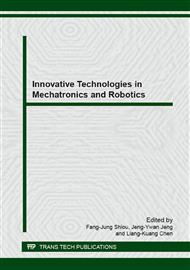p.54
p.60
p.66
p.74
p.82
p.90
p.97
p.104
p.112
A Study of Micro-Grinding and Inspection for Aspheric Glass Lens
Abstract:
This study discussed abrasive machining of aspheric glass lens, with the aim to increase the aspheric lens machining efficiency and reduce the back-end polishing process. The discussions covered "optical lens design", "Taguchi method optimization", "grinding force measurement", and "on-line real-time inspection". A window interface was designed by using Borland C++ Builder for optical glass design. The aspheric design parameters were substituted in it to obtain the machining path. In terms of Taguchi method optimization, the performance of electroformed grinding rod was compared with that of resin grinding rod. Taguchi method was used to look for optimization, and the quality characteristic was surface roughness. After experimental analysis, the optimization results were: using a resin binder grinding rod, the optimum parameter of 50,000 (rpm), forward grinding, feeding at 10 mm/min, grinding depth at 0.02mm, and aspheric lens surface roughness of 0.03μm. In terms of grinding force measurement, an eight-ring strain gage dynamometer was designed to measure the optimum grinding force. The measurement result showed that the grinding force in vertical direction was 3.2kg, and that in horizontal direction is 4kg. In terms of visual inspection, a CCD camera was mounted on the machine, which takes the image of workpiece immediately after it is machined. The form was inspected, and the dismounting error was reduced.
Info:
Periodical:
Pages:
82-89
Citation:
Online since:
June 2015
Authors:
Keywords:
Price:
Сopyright:
© 2015 Trans Tech Publications Ltd. All Rights Reserved
Share:
Citation:


